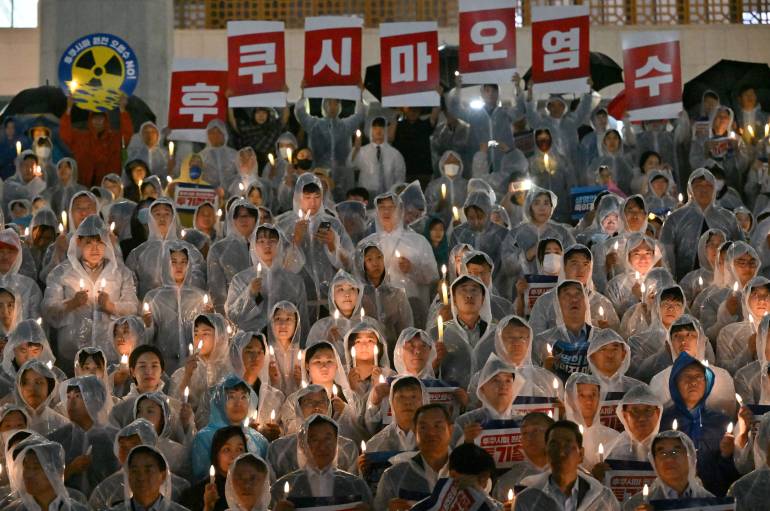Japan has started releasing treated radioactive water from the devastated Fukushima nuclear power plant, despite continued controversy over the decades-long discharge plan.
The seawater transfer pumps began the release into the Pacific shortly after 1pm local time (04:00 GMT) with plant operator Tokyo Electric Power Company (Tepco) announcing earlier that weather and sea conditions were suitable.
“Now, valves near the seawater transport pumps are opening,” a TEPCO official said via a video link from the site broadcast at the company’s Tokyo headquarters.
More than one million metric tonnes of the treated water, used to cool the wrecked reactors after the 2011 tsunami, is currently stored in some 1,000 tanks around the site and its removal is a key part of decommissioning the still highly dangerous facility.
The entire discharge process is expected to take as long as 40 years.
Monitors from the International Atomic Energy Agency (IAEA), which has backed the plan, will be on-site for the discharge, and samples of water and fish will be taken.
Japan says all radioactive elements have been filtered out except tritium, which is hard to remove from water. The hydrogen isotope is also discharged – at higher levels – by operational nuclear power plants, including in China and France.
The company will carry out four releases of treated water until March 2024, with 7,800 cubic metres of water released each time. The discharge that has just begun is expected to take about 17 days.
That water will contain about 190 becquerels of tritium per litre, below the World Health Organization drinking water limit of 10,000 becquerels per litre, according to Tepco. A becquerel is a measure of radioactivity.
‘Extremely selfish’
The plan has sparked continuing controversy despite Japan’s insistence that the process is safe and the backing of the IAEA, the United Nations’s nuclear watchdog, which approved the proposal in July, saying the impact on health and the environment would be “negligible”.
Shortly after the release started, China, which has lodged a formal complaint over the plan, again accused Japan of being “extremely selfish”.
“The ocean is the common property of all humanity, and forcibly starting the discharge of Fukushima’s nuclear wastewater into the ocean is an extremely selfish and irresponsible act that ignores international public interests,” China’s ministry of foreign affairs said in a statement.
Earlier, China and the territories of Macau and Hong Kong banned Japanese seafood imports from around Fukushima and Tokyo, and stepped up radiation monitoring. Hong Kong Chief Executive John Lee on Wednesday called the discharge “irresponsible”.
South Korea has also been cautious amid public concern, despite a government assessment finding no problems with the scientific and technical aspects of the release.

It has banned imports of fish and food products from Fukushima and said that would remain in place until public concern had eased.
On Wednesday night, South Korea’s main opposition party led a candlelit vigil against the discharge, and protests continued in Seoul on Thursday.
The Reuters news agency reported at least 14 people had been arrested in the capital after trying to enter the Japanese embassy.
The Fukushima Daiichi plant was devastated in March 2011 after it was overrun by a tsunami triggered by a 9.0 magnitude earthquake that killed nearly 20,000 people in northeastern Japan.
It was the world’s worst nuclear disaster since Chernobyl in 1986.
from Hacker News https://ift.tt/UsrAOmH
No comments:
Post a Comment
Note: Only a member of this blog may post a comment.